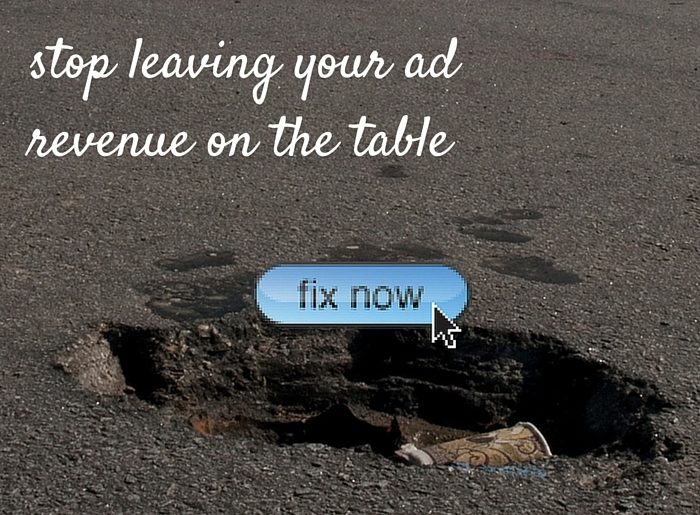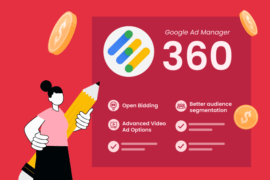So you have a DoubleClick for Publishers account, have a good hang of its basics, and are serving ads on one or more of your sites. You’re bringing in some ad revenue but really want to increase it. In this post, we’ll be discussing multiple ways using which you can maximize your ad revenue in DFP.
Let’s get right down to it.
1. Integrate DFP with Google AdSense
DFP makes it easy to integrate your Google AdSense account. AdSense’s large inventory of ads comes in handy when you need to fill your unsold and remnant ad space.
Place AdSense ads at the end of the display order line so they only display if no other higher paying ads are available to be displayed. With Google’s large ad inventory, you will never have an empty ad space.
2. Use Multiple Ad Networks
DFP allows you to serve ads from multiple ad networks. You can configure ad locations to display the highest paying ad from all available ad networks. If an ad is not currently available, the next highest paying ad will automatically be displayed. This will help maximize your ad revenue.
There are many ad networks besides just Google AdSense. Make use of them.
3. Sign Up for an Ad Exchange
Ad exchanges provide a platform where publishers can sell and auction off available ad space to advertisers. Many allow for real-time bidding so you always get the highest price for your ad inventory.
Keep in mind that an ad exchange will most likely not give you a 100% ad space fill rate. So, make sure you use other ad networks and AdSense as backups.
4. Configure Passback
First, let me give you an example of what a passback is. You may be serving ad impressions from a particular advertiser or ad network that is only looking for a specific number of ad impressions. When this quota is exhausted, the ad space is filled by the next available advertiser or ad network.
Take the time to configure all your ad passback chains (try the DFP passback tag) so you have a better chance of not having an empty ad space. Just taking advantage of passbacks can increase your ad revenue substantially.
5. Keep Non-Relevant Ads to a Minimum
If you are being paid per click, you’ll want to only use ads that are relevant to the content they are displayed along with. Don’t accept ads that have nothing to do with the content the viewer is seeing. These non-relevant ads will rarely be clicked.
If you do have to accept non-relevant ads, make sure you are being paid per impression and not per click. If an ad is relevant to the content on the page, it has a much higher chance of being clicked.
6. Use Odd Ad Sizes and Shapes
Most visitors are used to seeing the standard ad sizes and basically ignore them (this is known as banner blindness). You need to get their attention by using something they aren’t used to seeing. Odd shapes and sizes work well for this purpose. Test a few odd-shaped or odd-sized ads out and see how they perform for you.
7. Increase Your Pageviews per Visit
One of the best ways to increase your ad revenue is by increasing the amount of traffic coming to your website. We’ve previously covered this.
Now let’s talk a little about increasing the pageviews per visit on your site. What I mean by that is getting more page views per visitor. The higher the page views, the more ads displayed to each visitor.
If you have any long blog posts or articles, break them up so they appear over multiple pages. If you have a photo gallery, break that up so each photo appears on a new page.
Basically what I am getting at here is that any time you can paginate, do it. The second thing you should do is increase the amount of internal linking, i.e., hyperlinking to content on your own website.
8. Study Your Ad Analytics
Many publishers only use their ad analytics to see how much money they are making or are owed. Don’t be one of them! You can get so much more from really studying your ad analytics.
Look at ad clicks vs impressions, look at conversions, and look at revenue earned per ad impression. Does one advertiser seem to bring in more revenue? Compare the analytics to ads located in different locations on your site. Does one area seem to do better with particular advertisers or ad types? Are you exceeding any frequency caps of individual advertisers? Are you seeing seasonal trends that produce more clicks on specific ads?
Use your ad analytics to your advantage. Dig deep into them, it will pay off with higher ad revenue.
9. Test Different Ad Sizes
Advertisers and ad networks usually have a variety of ad sizes for publishers to use. Take advantage of these and test different sizes of ads. You may find that changing out a smaller ad for a larger one draws more attention to it and more clicks. But be careful that you don’t ruin the visitor’s experience by using too ads so large that they break up the content flow.
You will also want to test ad orientation and shapes. Compare click rates for a horizontal banner, a square banner, and a skyscraper banner placed on the same page.
10. Test Different Ad Types
Don’t get in a rut of using a single ad type. Different ad types work best in different situations, locations and for different traffic sources. Test the different ad types in each ad spot to see what works best.
Here are the most popular ad types you should be testing.
- Banner ads of all sizes and types
- Contextual text ad blocks
- Standard text ads
- Video ads
- Native style ads
- Multiple choice, poll style ads
- Simple text link ads
You may just get surprised at the ad type that works best for each ad spot on your site.
11. Test Different Ad Locations
If you’ve researched ad placement, I’m sure you’ve seen all the so-called experts touting to place ads above the fold, integrated with content, etc. This could work fine for your site or it may not. A lot is going to depend on your site layout, traffic flow, and site visitors.
Test different ad locations and see what locations work best on your site. You may discover that your site visitors tend to click ads located in nonstandard places. You will never know until you take the time to test ad locations.
12. Test Different Ad Pricing Models
Many publishers will only sell ad space to advertisers that will pay using the CPM pricing model. These publishers could very well be leaving money on the table by using this practice.
Test each of the following ad pricing models and see what one brings in the most ad revenue for you.
- CPM
- CPC
- CPA
- Flat Rate
- Affiliate Commission
Depending on the content of your site, you most likely will find that a particular ad pricing model works best for you. This, of course, can differ from site to site.
13. Change and Optimize Often
Times change. Markets change. Trends change. Traffic plateaus. Seasons change. Just about everything changes constantly. Keep on top of these changes to help maximize your ad revenue. Don’t be afraid to test even the smallest things. Sometimes a tiny change or optimization brings in a good amount of extra ad revenue.
I hope that you’re able to use these strategies to maximize your ad revenue. Or, maybe one of the strategies got you thinking about an entirely different way to increase your ad revenue. Just keep testing new strategies and implement the ones that work well for you.
One final thought. Carefully read the ToS of each advertiser, ad network, and ad exchange you use. Make sure the strategies you test or implement are allowed and do not violate any of their rules. You want to maximize your ad revenue, not lose it by accident.
A growth blog for professional bloggers and ad ops professionals.







